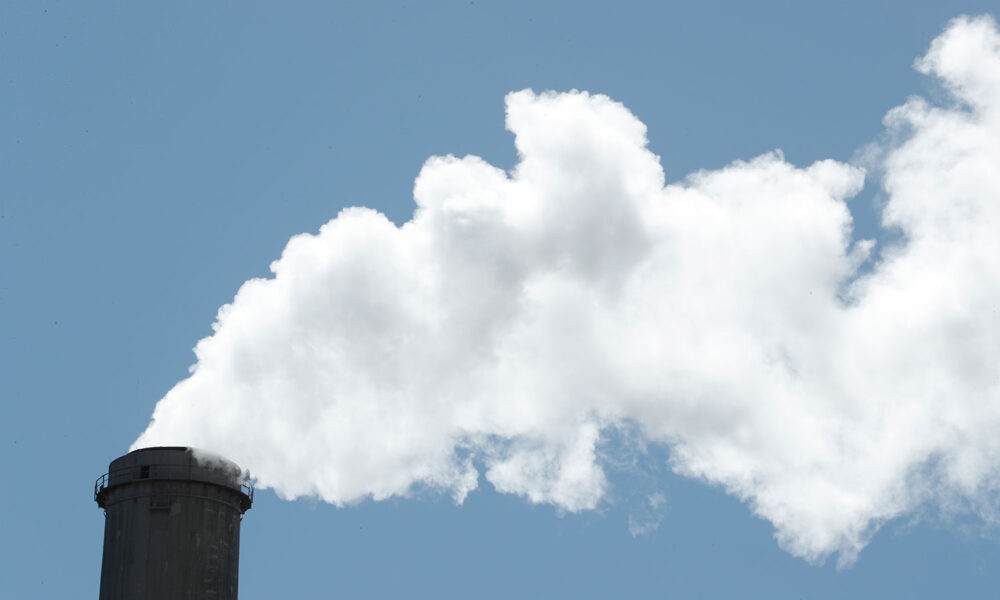In the past couple of years, heat-trapping emissions from California’s electricity sector have been going down.
Are you surprised? Of course not! California is a leader on deploying clean energy, setting new records seemingly every year. Because of that, California’s emissions have been on a steady march downward year after year… Right?
Wrong. I’ve been tracking this carefully, and I’ve been dismayed that, prior to the past few years, California’s electricity sector emissions stayed constant for roughly half a decade.
As California continues to pursue its clean energy and climate goals, it’s important to pause every now and then to take stock of progress. I wanted to understand, why did emissions from California’s electricity sector flatline for so long between 2017 and 2022? And what factors have led to the recent decrease?
I’ll answer those questions and more in this blog.
Emissions ups and downs
First, it’s important to recognize that California has made tremendous strides in reducing electricity sector emissions over the past two decades. California has cut these emissions in half from the peak in 2001. But it’s been a bumpy ride down.
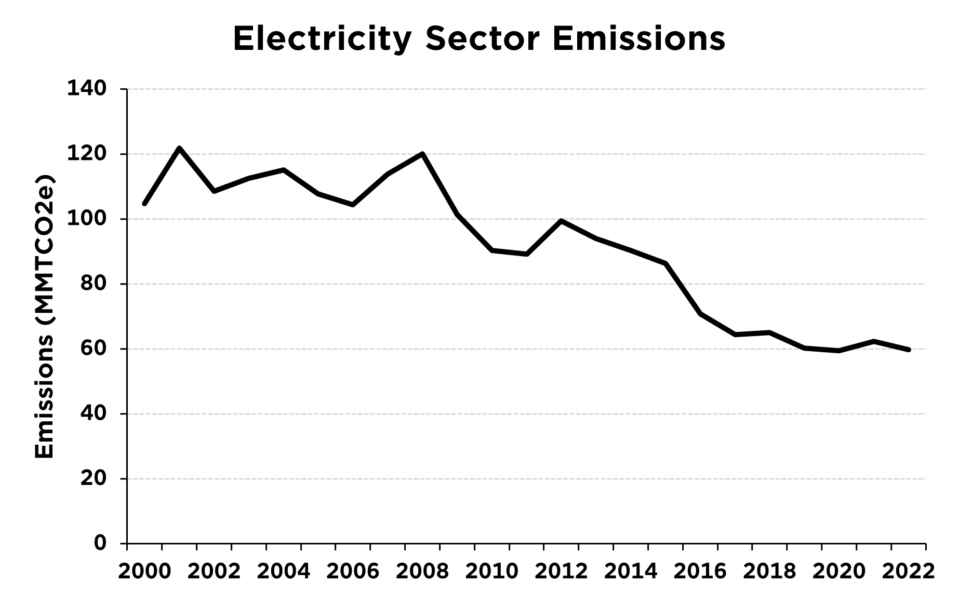
For example, a severe drought in 2007-2009 drastically reduced hydroelectric generation, which led to a spike in emissions when fossil fueled generation filled the gap. Then in 2012, another spike in emissions occurred when the San Onofre Nuclear Generating Station suddenly shut down, which once again led to fossil fueled generation filling the gap.
The emissions trajectory of California’s electricity sector has always been bumpy, but the flatline post 2017 was particularly curious to me. So let’s zoom in on the past decade.
Renewable energy on the rise
The first thing I went to examine was recent trends in California’s clean electricity generation, and indeed, the state has made tremendous strides in adding renewable energy to the grid over the past decade.
Unsurprisingly, the star of California’s clean energy transition has been solar. Solar generation has soared, nearly quintupling since 2014. Wind generation started at much higher levels than solar and still increased by nearly 40% over the same period. Nuclear, geothermal, and biomass generation have all remained essentially constant over the past decade.
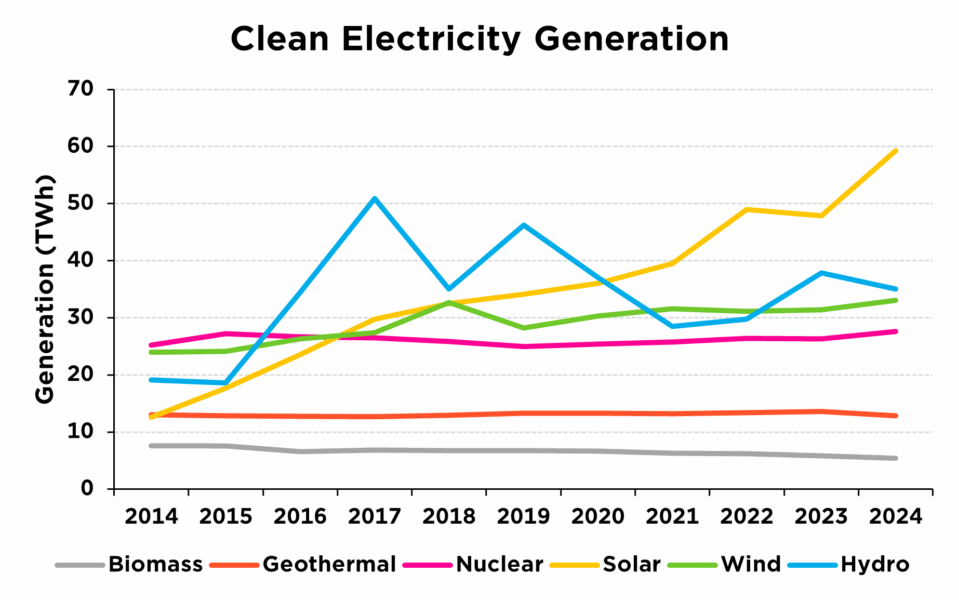
And then there’s hydropower, the spiky blue line that bounces all over the graph. After starting out at very low levels due to a multi-year drought, hydro generation spiked in 2017, a year that saw record levels of precipitation (along with the Oroville dam failure!). Hydropower then continued to bounce around depending on how wet the year was. And because California gets so much electricity from hydro, this phenomenon is one of the keys to answering my questions.
Clean and emitting generation flatline
Looking at clean electricity generation is only half the picture. The other half is emitting generation, particularly natural gas and unspecified imports, which contribute significantly to California’s heat-trapping emissions. And when you put all the pieces together, it becomes clear why California’s electricity sector emissions stagnated.
The answer: In total, both emitting and clean generation were essentially constant from 2017-2022.
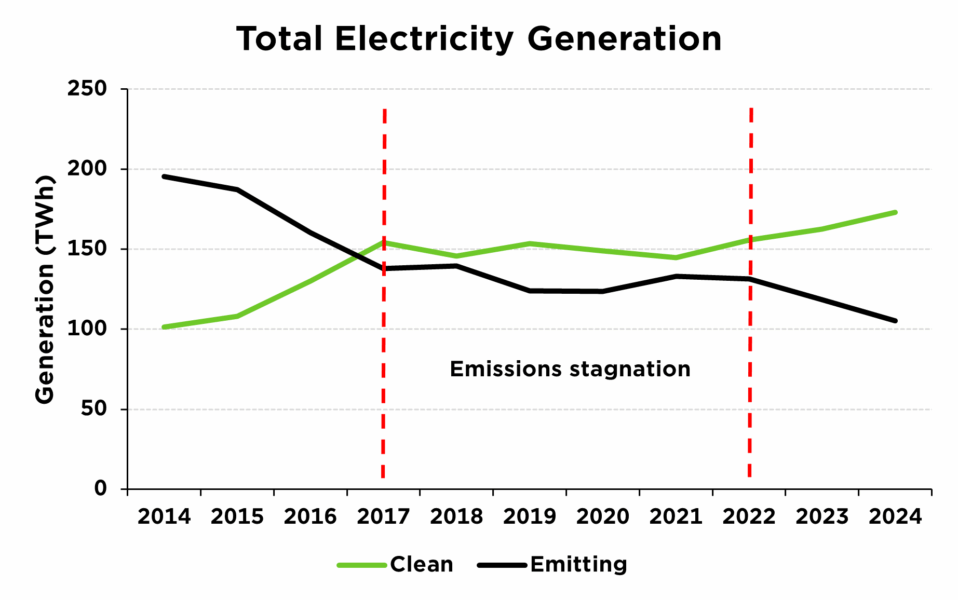
On the clean side, when you add up all the sources of generation, you end up with a relatively flat line. That’s because hydro generation was much higher earlier in the 2017-2022 period and decreased later on, counteracting the rise in solar generation.
On the emitting side, roughly three quarters of emitting generation comes from gas. While there was a slight uptick in gas generation in recent years, that was offset by a sharp decline in unspecified imports. Coal also continued its steady decline, but since coal is already such a small part of California’s energy mix, it barely registers on the graph. So in total, generation from emitting resources was relatively flat from 2017-2022.
Finally, I should mention that, despite all the talk about rapid load growth due to data centers, manufacturing, electric vehicles, etc., energy demand on most of California’s grid has remained quite stable over the past decade. (Though that’s in part because the growth of rooftop solar has offset small increases in demand.) So load growth isn’t a big factor influencing recent trends in electricity sector emissions. However, electricity demand is projected to increase significantly going forward, and those future increases in demand could change the story around future emissions trends. (But to mitigate those impacts, it’s critical to add electric vehicles and data centers to the grid in a way that helps drive down emissions and supports grid reliability!)
And there you have it. Since emitting generation was relatively constant, electricity sector emissions also held steady.
With that mystery solved, let’s move on to the good news.
Emissions now trending down
As I mentioned at the outset, California’s electricity sector emissions have resumed their downward trend in the past couple of years. The state-wide electricity sector emissions data in the first graph came from the California Air Resources Board (CARB), and at the time of writing, CARB has not yet released data for 2023 and 2024; however, we do have data from the California Independent System Operator (CAISO).
CAISO serves roughly 80% of California, so CAISO emissions track closely with state-wide emissions. And finally, after years of stagnation, CAISO emissions dropped significantly in 2023 and 2024. And by looking at CAISO emissions from the first six months of each year (the dotted line below), it seems likely that emissions will at least hold steady in 2025.
After a long pause, clean generation is once again pushing fossil-fueled generation out of the energy mix and bringing down emissions.
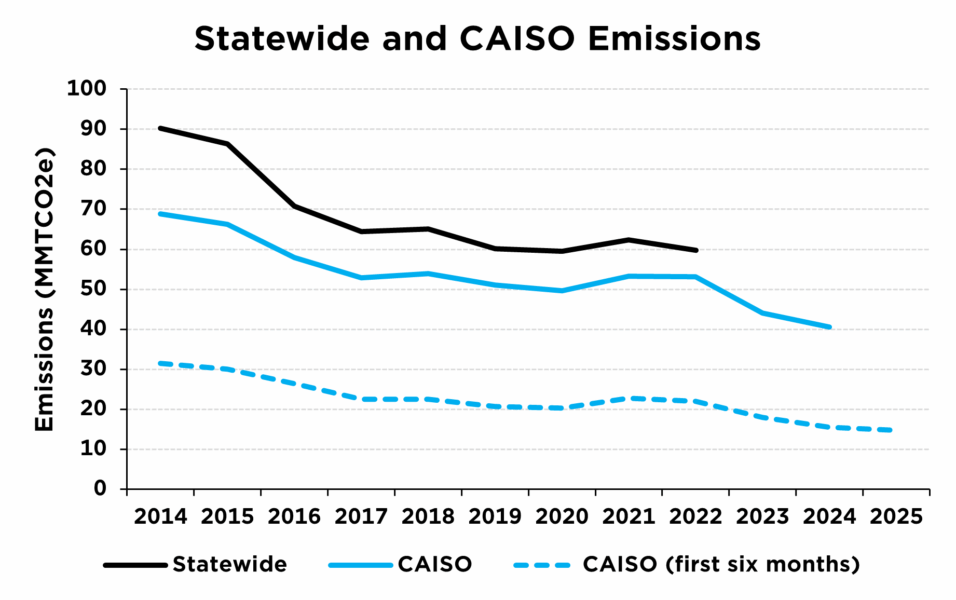
Reaching California’s clean electricity goals
Looking ahead, California has ambitious clean energy goals, and there’s still a long way to go to achieve them. The California Public Utilities Commission (CPUC) establishes goals for the electricity sector in its Integrated Resource Planning (IRP) process, and the Commission’s most recent IRP decision established emissions targets for specific years.
The near-term goal is to reduce state-wide electricity sector emissions down to 30 MMT by 2030. It’s certainly possible, but to get there, utilities will have to maintain the pace of reductions that we’ve seen over the past few years. That means continuing to build solar, wind, and energy storage at a rapid clip. It also means avoiding overreliance on hydro to deliver emissions reductions since hydro generation has been so volatile, and it may become even more volatile with more extreme weather in a changing climate.
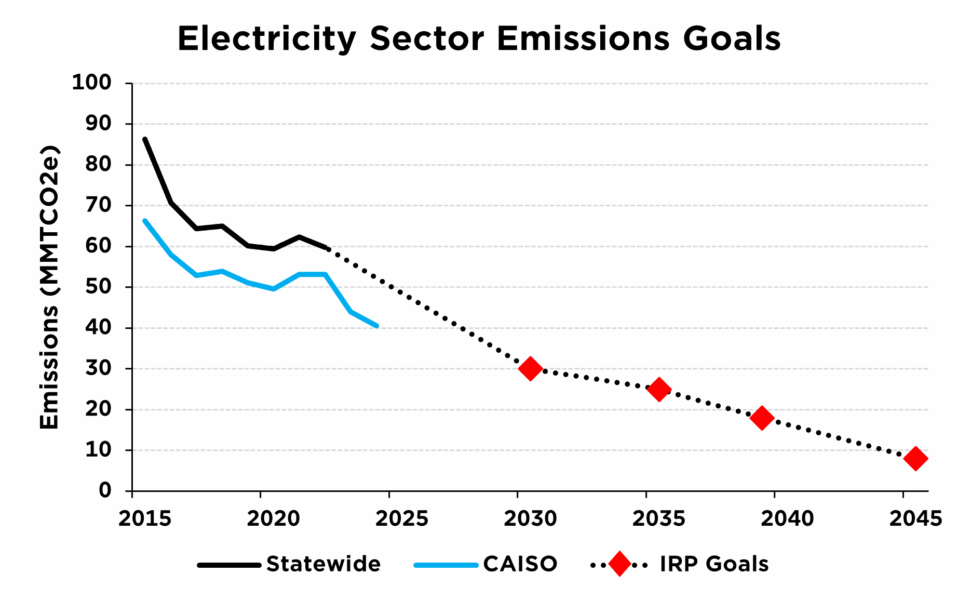
Unfortunately, California’s investor-owned utilities have started to cast doubt on the feasibility of these goals. PG&E, SCE, and SDG&E have raised concerns about the loss of federal clean energy tax credits for wind and solar and data center load growth making these goals unrealistic.
But now is not the time for California to dial back its clean energy ambitions. California has been hard at work to pass new policies that will make the clean energy transition more affordable, such as public financing for large transmission projects and expanding western energy markets through independent governance.
With California’s electricity sector emissions finally trending down again, the state should stay the course to reach its current goals, all while continuing to identify and implement solutions that make the grid more reliable and affordable.
